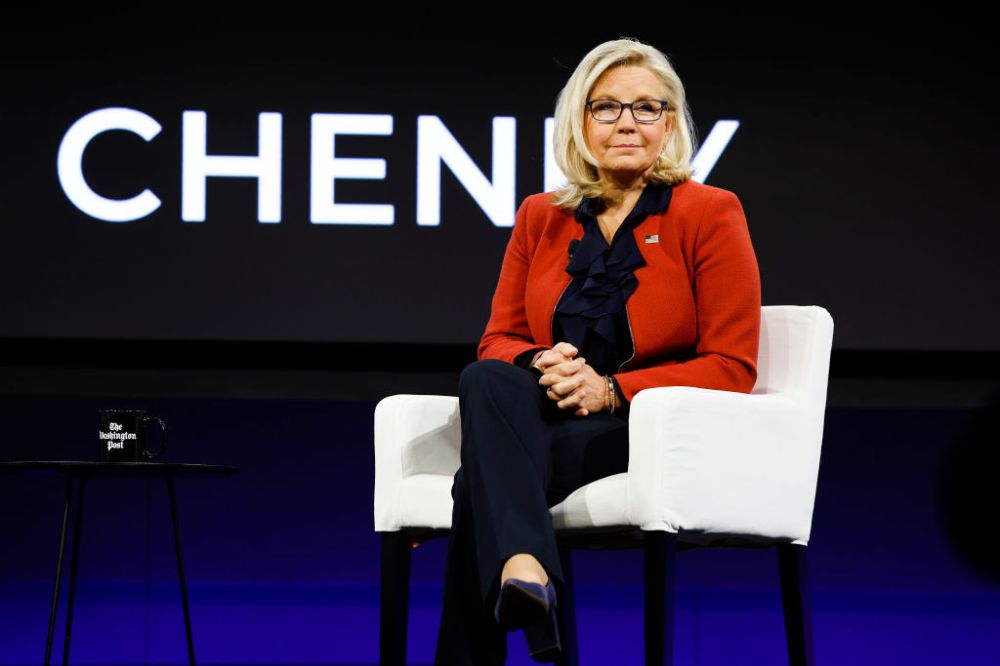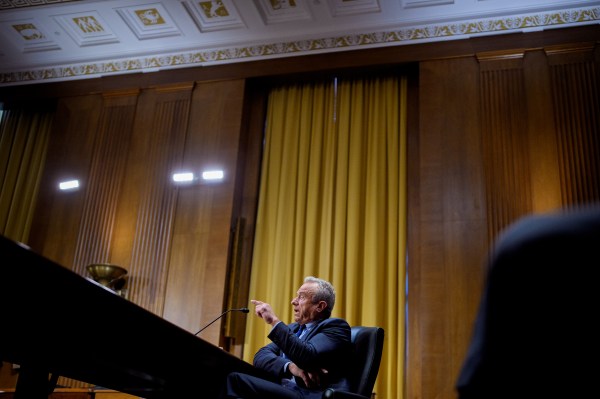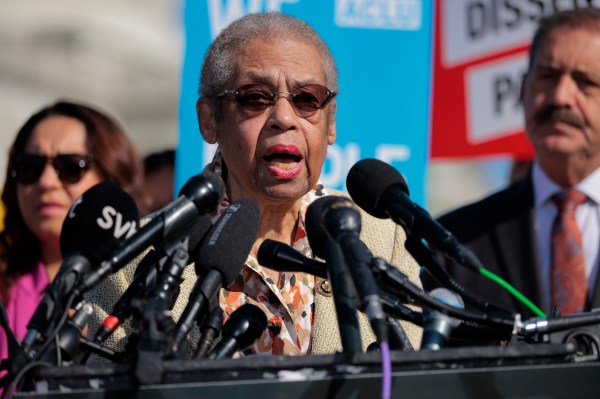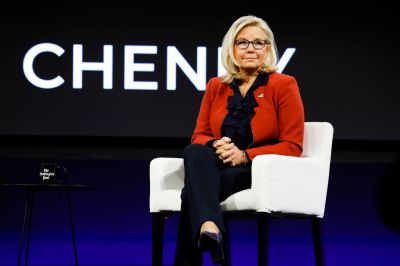For some of us, the most gratifying moment of the midterms came not on Election Night but six days later.
I had forgotten that Kari Lake mocked Liz Cheney after Cheney’s PAC ran an ad in the closing days of Arizona’s gubernatorial race urging undecided voters to oppose her. “Thank you for your generous in-kind contribution to my campaign,” Lake sneered in a letter published on social media. An “anti-endorsement” from Republicans’ least favorite Republican would add 10 points to her lead in the polls, she projected.
But someone didn’t forget. When the race was finally called on Monday for Lake’s opponent, Democrat Katie Hobbs, Cheney hopped onto Twitter to respond belatedly.
The scourge of MAGA, driven from Congress for prioritizing democracy over Trump’s claims to power, had gotten revenge by helping to vanquish his most ardent apprentice. Only the foulest populist could fail to relish it.
Back in August I reflected on the strange niche Cheney now occupies in American politics. Most Republicans despise her as a traitor. Most Democrats admire her for standing up to Trump but will never shed their suspicions of Dick Cheney’s very conservative daughter. She’s a politician without a constituency, in theory.
In practice, there’s reason to think she punches way above her weight as an influencer.
More than one poll taken this summer found 15 percent or so of Republicans continue to view her favorably. At last check YouGov had her at 9 percent “very favorable” among Republicans and independents and at 8 and 16 percent “somewhat favorable” within those two groups, respectively. Normally we don’t think of leaders with sub-25 percent favorable ratings as influential.
But when you consider that pro-Cheney Republicans and indies are likely to be chilly toward the Trumpified GOP to begin with, the calculus changes. Those folks are primed by conviction and disposition to become swing voters. And, being Cheney fans, they’re apt to heed warnings that democracy is on the ballot in their local election. We’ll never know how many in Arizona watched Cheney’s anti-Lake ad and decided that they’d better make a point of turning out for Hobbs, but I bet it wasn’t zero.
In fact, of the Democrats who received Cheney’s endorsement this year, all won tight races.
I won’t tell you her support was decisive in any of them. Endorsements seldom are in American politics. But I will tell you that I share Greg Sargent’s belief that a small yet meaningful contingent of right-leaning MAGA skeptics are making the difference for Democrats in close elections where Trumpy candidates are on the ballot. Call ‘em whatever you like—Never MAGAs, the Cheney bloc, the pro-democracy coalition, what have you.
They’re real. And they’re spectacular.
I think.
They were real in 2020. If you’ve studied the results of that election, you know there’s nothing new about Trump-era conservatives helping to elect Democrats.
The partisan numbers in that year’s national exit poll cut against my theory at first glance, with a roughly equal share of Democrats having voted for Trump (5 percent) as Republicans who voted for Biden (6 percent). But when you look deeper, at ideology, a disparity emerges. Ten percent of liberals supported Trump in 2020. Fourteen percent of conservatives supported Biden.
The disparity widens when you consider other demographics. Biden won independents in 2020 by 13 points and self-described moderates by, no joke, 30.
It goes without saying that not all or even most indies and moderates are anti-Trump right-wingers. Independents run the gamut from disaffected progressives to Liz Cheney types. But it also should go without saying that many conservative Trump skeptics have fled the party since 2016 and piled into the independent column. One of the best reasons to believe Trump will ultimately defeat Ron DeSantis in 2024, in fact, is because the base of registered Republicans has gradually been denuded of Trump-leery moderates. Because of attrition over time, DeSantis will face a primary electorate in which practically everyone left is pro-Trump.
The 2020 trends among independents and moderates aren’t proof of anti-Trump former Republicans crossing over in volume to help elect Biden, in other words. But they’re … suggestive.
When we dig down into that year’s swing state exit polls, the suggestive trends continue.
In Arizona, site of Biden’s narrowest victory, the president won 9 percent of Republicans. Trump won just 3 percent of Democrats by comparison. That gap also showed up in ideology, with Trump claiming 6 percent of the liberal vote while Biden claimed 11 percent of conservatives. Among independents and moderates, he won by 11 and 35(!) points, respectively.
I wonder how many “McCain Republicans” and former Republicans, so unwanted by the new right’s populist heroes, turned out in Arizona that year to help Biden over the finish line.
Georgia was the site of Biden’s second-narrowest victory and again the pattern repeated. Trump won 4 percent of Democrats and 12 percent of liberals but Biden topped him with 6 percent of Republicans and 14 percent of conservatives. Again, he won easily among independents, this time by 9. And again he blew the roof off with moderates, winning by 32.
Pennsylvania? The partisan gap was narrow as Trump took 7 percent of Democrats compared to Biden’s 8 percent of Republicans. But the ideological gap turned up again, with Biden taking 12 percent of conservatives while Trump had to make do with 8 percent of liberals. Same old story with independents and moderates, as Biden won them by 8 and 17 points, respectively.
Finally there was Wisconsin, where Biden won 7 percent of Republicans and 11 percent of conservatives versus 4 percent of Democrats and 8 percent of liberals for Trump. Independents went Democratic by 12 points, and moderates by 22.
In one critical state after another, more conservatives crossed the aisle to vote for the other party than liberals did. And among the two most “centrist” cohorts of the electorate, where anti-Trump former Republicans are most likely to be found, Biden put up big margins that ended up proving decisive.
“But wait,” you say. “There might be a meaningful bloc of right-wingers willing to vote against Trump. But that doesn’t mean there’s a meaningful bloc willing to vote against his MAGA disciples.”
Fine. Let’s look at the numbers from last week’s election.
The single most arresting data point from the 2022 national exit poll is that Democrats topped Republicans among independents, 49-47. With inflation at a 40-year high and Joe Biden’s approval rating sitting in the low 40s, I would have bet my life savings that the GOP would win indies, probably going away.
Among self-described moderates, it was worse. Whatever anxiety they might be feeling about crime and the rising cost of living, they set it aside and broke for Democrats last Tuesday by 15 points.
This is, again, at best only circumstantial evidence of Never Trumpers and former Republicans helping to tip the balance against the GOP. But the evidence gets stronger when we look at exit polling in the battlegrounds.
Kari Lake may well have been done in by pro-Cheney conservatives in Arizona. Lake won 4 percent of Democrats this year but her opponent, Katie Hobbs, took 9 percent of Republicans. (According to Associated Press estimates, it was more like 11 percent.) Just 2 percent of liberals broke for Lake while 8 percent of conservatives broke for Hobbs. Independents also went Democratic, by 9 points. And moderates went big for the Democrat, by 20.
All of which feels familiar in light of the 2020 exit polling.
Blake Masters did even worse in Arizona’s Senate race. Democrat Mark Kelly took 9 percent of Republicans and 8 percent of conservatives versus 2 percent of Democrats and 1 percent of liberals for Masters. And Kelly enjoyed landslide margins among independents and moderates, winning by 16 and 30 points, respectively.
In Georgia, the “Never MAGA” bloc may have prevented Herschel Walker from claiming an outright victory on Election Day. Despite Brian Kemp cruising to reelection at the top of the ticket, Democrat Raphael Warnock finished ahead in the Senate race thanks to 11 percent of conservatives breaking his way versus 5 percent of liberals breaking toward Walker. Warnock won independents by 11 and moderates by 34. I’m keen to see how many Republicans end up turning out for him in the runoff.
Same story in Wisconsin, where Democrat Tony Evers eked out reelection as governor over Trump-backed Tim Michels. Michels won 2 percent of Democrats and 5 percent of liberals; Evers beat that easily with 7 percent of Republicans and 11 percent of conservatives. Independents were fairly close in this one, with Evers winning by just 4, but moderates once again went heavily Democratic by 21 points.
Wisconsin’s Senate race is an interesting contrast to its gubernatorial race because Republican Ron Johnson ended up pulling through. How’d he do it? By holding down defections. Johnson’s progressive opponent, Mandela Barnes, scared off righties with numerous soft-on-crime pronouncements. He ended up winning just 4 percent of Republicans and 8 percent of conservatives, with independents splitting evenly at 49 percent. The “Never MAGA” Cheney bloc on the right is willing to elect a normie Democrat over a MAGA Republican, but evidently not an overtly left-wing Democrat over a Republican who’s been in office since the pre-Trump era.
Arguably the strongest evidence of a “Never MAGA” vote turned up in Pennsylvania, where election denier and January 6 rally attendee Doug Mastriano was on the ballot. Mastriano may have been the most cartoonishly fringe statewide candidate on the ballot anywhere in the country this year, so much so that he largely declined to campaign conventionally and stuck to preaching to the choir in Facebook livestreams instead. He ended up losing an almost unfathomable 16 percent of Republicans and 13 percent of conservatives to Democrat Josh Shapiro, who ceded a mere 3 percent of Democrats and 4 percent of liberals back to him. Shapiro also won independents by 31 points and moderates by, uh, 43.
All told, for the second consecutive election cycle, more Republicans and conservatives opted to cross the aisle than Democrats and liberals did in key races. And this time, Trump wasn’t on the ballot. On the contrary, between the poor economy and the usual midterm “fundamentals” in which out-party voters show up to punish the president, there was every reason to expect the trend might run the other way.
It didn’t, not in major statewide battlegrounds—and not in congressional races either. When the New York Times’ Nate Cohn went back through Tuesday’s results, he found a striking difference in support between Trump-endorsed House candidates and other Republican candidates.
Conceivably the difference there is due entirely to Democrats and left-wing independents turning out in greater numbers in House elections with Trump nominees on the ballot. But given the pattern we’ve seen of Republicans crossing the aisle in Senate and gubernatorial races, it’s a safe bet that many of them crossed the aisle down ballot as well. Just ask Lauren Boebert and Joe Kent.
Or ask this analyst, who averaged out the crossovers across all battlegrounds.
Finally, let’s come back to the national exit poll. Others have noted the remarkable fact that voters who “somewhat disapprove” of Biden’s performance nonetheless preferred Democratic candidates, another bit of circumstantial evidence that points to some right-leaning voters gritting their teeth and voting blue despite their misgivings about liberal policy. As remarkably, nearly as many voters (28 percent) said they were casting their vote to oppose Trump—a man who’s been out of office for nearly two years—as said they were casting their vote to oppose the sitting president (32 percent), as typically happens in midterms.
But most remarkable is how many Republicans were part of the group who said they were voting to oppose Trump this year. Members of Trump’s own party made up 8 percent of that cohort; by comparison, Democrats accounted for just 4 percent of the group that said it was casting a vote to oppose Biden. And among the majority of voters who said they had an unfavorable view of Trump, fully 20 percent came from the GOP.
Lotta anti-Trump righties out there, it turns out. And their antipathy to Trump might have made the difference last Tuesday.
Then again, it might not.
The great confounding factor in trying to interpret this election is abortion.
It may well be that Republican crossover votes made the difference for Democrats in tight races this year. But were those votes driven by antipathy to Trump, MAGA, and election denialism? Or were they pro-choicers driven by antipathy to the Dobbs ruling and jitters about how their party might govern with respect to abortion if handed power?
Consider Pennsylvania’s Senate race. The usual pattern of a normie Democrat battling a Republican radical was reversed there. Mehmet Oz was unlikable for many reasons but not because he was fringy on policy or outspoken about “rigged elections.” It was John Fetterman, the Democrat, who carried ideological baggage from his years of hardline progressivism, particularly on criminal justice reform.
In a race like that, you might expect the crossover votes among Republicans and Democrats, conservatives and liberals, to look starkly different from how they looked in the other statewide races described above. They don’t. Fetterman won 10 percent of Republicans and 9 percent of conservatives versus 5 percent of Democrats and 6 percent of liberals for Oz. And he cleaned up among independents and moderates, winning those groups by 20 and 30 points, respectively. Were the Cheney Republicans crossing over in that race too? If so, why?
Maybe they were. Maybe Trump’s endorsement left too much MAGA stank on Oz for comfort despite Oz’s image as a moderate. Or maybe Fetterman benefited from the huge crossover vote in the gubernatorial race, with disgusted Cheney Republicans aiming to punish the GOP all the way down the ballot for having nominated the repulsive Mastriano.
Or, perhaps, some rural Republicans dug Fetterman’s blue-collar “vibe” and opted for him over the unctuous celebrity doctor from TV.
But it’s possible that the Republicans who crossed over for Fetterman did so not because they’re “Never MAGA” but because they’re “Never Dobbs.” Check this out.
In Pennsylvania, asked what issue was most important to their vote, 37 percent said abortion. That was easily the highest share of any issue polled, 9 points ahead of inflation. And 62 percent of Pennsylvania voters said they wanted abortion to be legal in most or all cases. Fetterman won three-quarters of those voters versus 10 percent of those who said otherwise.
If abortion was the difference for him in winning over a critical mass of Republicans, maybe it was also the difference for Katie Hobbs. And Mark Kelly. And Raphael Warnock. And Tony Evers.
Disentangling the electorate’s motives this year will vex political analysts for years to come. Until they do (if they ever do), the safe noncommittal take is to assume that neither the Dobbs backlash nor the anti-MAGA conservative backlash was sufficient in itself to deliver the results we saw last Tuesday. Combined, however, they mustered enough crossovers to flip races that could have gone either way. Particularly Kari Lake’s race, which she’s likely to end up losing by less than a point.
Time will tell how the GOP manages its abortion problem. But one thing it could do right now to manage its problem with Cheney Republicans is, perhaps, to stop ostentatiously kissing them off in the belief that a smaller, more populist party is preferable to a larger, less populist one. A few days ago Mark Levin demanded to know why, if Barack Obama could campaign for Democrats this year, George W. Bush and Chris Christie couldn’t be bothered to campaign for Republicans. To which the entirety of Twitter responded, “Have you heard what MAGA Republicans say about George W. Bush and Chris Christie?”The Trumpified GOP would catch more flies with honey than with vinegar. But if populists don’t want to make that accommodation with Never Trump “human scum,” even at the cost of losing more tight elections, I understand. The contempt they feel for anti-Trump Republicans is deep and real. And very much mutual, needless to say.







Please note that we at The Dispatch hold ourselves, our work, and our commenters to a higher standard than other places on the internet. We welcome comments that foster genuine debate or discussion—including comments critical of us or our work—but responses that include ad hominem attacks on fellow Dispatch members or are intended to stoke fear and anger may be moderated.
With your membership, you only have the ability to comment on The Morning Dispatch articles. Consider upgrading to join the conversation everywhere.